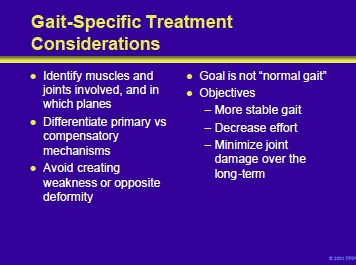
A number of gait-specific considerations are important when considering treatment. The specific muscles and joints that are involved in the gait disturbance should be identified; in addition, it is important to determine the plane of movement affected. Since some of the gait abnormalities may be the result of compensatory mechanisms rather than spasticity per se, it is important to recognize the differences.
Furthermore, the therapist should avoid exacerbating the situation by creating weakness or opposite deformity. The therapeutic goal is not a “normal” gait. Instead, the objective is a more stable gait that is produced with less effort and oxygen consumption and that minimizes joint damage over the longterm.
Next Section : Management of spasticity in cerebral palsy Part III Treatment of Patients with cerebral palsy and spasticity
Section Index
- Management of spasticity in children with cerebral palsy Part I
- Management of spasticity in cerebral palsy Part II Passive and Active Examination
- Management of spasticity in cerebral palsy Part III Treatment of Patients with cerebral palsy and spasticity
- Management of spasticity in cerebral palsy Part IV - Rehabilitation Management
- Oral Medications for the Treatment of Spasticity
- Intrathecal Baclofen for Spasticity in Cerebral Palsyy
- Local Anesthetics, Neurolytics, and Chemodenervation for the Patient with Cerebral Palsy and Spasticity
- Management of spasticity in cerebral palsy Part VIII -Botulinum Toxin
- Neurosurgical Interventions for Spasticity in Children with Cerebral Palsy
- Orthopedic Interventions for Spasticity in Children with Cerebral Palsyy
- Management of spasticity in cerebral palsy Part XI-Alternative Medicine in Spasticity Management
- Management of spasticity in cerebral palsy Part XII Case Studies
- Management of spasticity in cerebral palsy Part XIII Document Downloads
- Self Assessment
Add comment